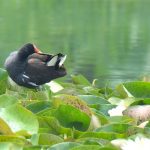Blog Entry Written by Team: Red Swamp Crayfish (Procambarus clarkii)
博客撰写小组:小龙虾组(Procambarus Ccarkii)
Team Members: Sasha Main (Queen’s), Zhizhou He (Fudan), and Zihan Dong (Waterloo)
小组成员:萨沙·梅恩(女王大学)、何知舟(复旦大学)和董子涵(滑铁卢大学)
Weather: Light showers in the morning, cloudy, humid, and about 30 degrees Celsius all day. Heavy rain came in the afternoon which cleared up around 5pm, followed by partly cloudy, humid weather with a cool breeze.
天气:全天气温约30℃早上阵雨转多云,空气潮湿。下午有大雨,至五时方晴。其后夜间多云,天气潮湿并伴有凉风。
For our third and final day of wetland assessments at GongHu, we left at 8am sharp. Upon arrival we used the ‘Bobo courier service’ (aka Dr. Bojian Chen with an electric tricycle) to transport the experimental equipment to the various locales. We had some logistical challenges organizing the movement of the equipment among sampling locales on the previous day as the reconstructed wetland is a quite large at 2.32km2. This resulted in half the groups finishing their data collection and the other tree groups needing to infill some data gaps. It worked out quite well as some of us were out gathering our data (e.g. water chemistry measurements, birding point counts, physical observations and benthic macroinvertebrate samples) or at the local café on the causeway. Our team headed out to our site (31° 27′ 33″ N 120° 20′ 36″) to finish some physical observations and do one more fixed radius bird count. We were accompanied by the cute stray pup from the café – mostly because we fed her dried bananas.
在湿地评估的第三天(也是最后一天),我们早上8点整集合完毕,分别打的离开酒店。抵达贡湖湾后,波波继续着他这几天的“快递小哥”业务。由于贡湖湾湿地面积为2.32平方公里,前一天实地考察时我们很难让检测设备在小组间自由流通。这导致了今天一半的组完成了他们数据收集的同时,另一半的组却有大量的测试要做。总的来说,咱们这班人马要么呆在咖啡厅里操劳各种项目,要么就分散到采样点收集着诸如水化学测量、观鸟记录、样地物理观测和底栖无脊椎动物样本等数据。就我们小龙虾组而言,咱仨首先来到先前的采样地点(北纬31°27‘33“,北纬120°20’36”),补充完成了一些物理观测后,又做一次固定半径内的鸟类计数。期间,有一只可爱的流浪小狗(小黑)陪着我们一路从咖啡店到样地再回到咖啡店——可能主要是因为她喜欢我们喂的干香蕉。
Our sampling site is a point of land surrounded by open water on the causeway, with minimal aquatic vegetation coverage. We noted that the bank has a northern aspect and was comprised of a man-made metal cage filled with stones beside ‘natural’ grassy banks on a 4° incline. During our bird count we spotted one Common Moorhen (Galinula chloropus), two Little Grebes (Tachybaptus ruficolis), four Long-tail Shrikes (Lanius schach), about 40 Intermediate Egrets (Ardea intermedia) outside, three Black-billed Magpies (Pica pica), one Grey Heron (Ardea cinerea) and two unknown species. It was much more difficult without Dr. Lougheed, but it made us appreciate the knowledge and skill required to be a great birder. By the time we finished up, most groups had collected their data and Renata even collected water chemistry samples from TaiHu with Dr. Chen for comparison in our report.
我们的观测点是一个突出的人工平台,其周围是开放的水域和极少植被覆盖的堤道。我们注意到河岸是一个里面填装着石头且面北的人造金属笼子,再旁边则是天然的绿堤。绿堤倾斜度手机测量为4°。在观鸟的过程中,我们发现了一只黑水鸡(Galinula chloropus)、两只小䴙䴘(Tachybaptus ruficolis)、四只长尾伯劳(Lanius schach),大约40只中白鹭(Ardea intermedia)停栖在观测范围之外、三只黑嘴喜鹊(Pica pica)、一只灰鹭(Ardea cinerea)和两种未知物种。没有了Lougheed博士,我们的观鸟过程变得困难得多,但这使我们深刻认识到,成为一名经验丰富知识广博的“鸟人”有多么不易。等到我们组完成的时候,大多数小组已经收集好了他们的数据,同时Renata甚至和波波一起从太湖收集了水化学样本用以在我们的报告中作比较研究。
Fairly heavy rain started during lunch, so Dr. Wang and Dr. Lougheed kindly arranged some presentations and a movie for the afternoon. The first presentation was from one of our fellow students Allen Tian, who has just started his master’s program in Dr. Wang’s laboratory (co-adivsed by Dr. Lefevbre) studying the use of unmanned aerial vehicles (UAVs) for surveillance of cyanobacteria – to serve as an early warning and monitoring system. The genus Microcystis can release harmful toxins when they die, such as microcystin, with potentially profound ecological and economical impacts. Allen informed us of the difficulties in controlling cyanobacteria, the pros and cons of different monitoring systems, the obstacles of using UAVs and his hopes for future developments. One funny (but serious) challenge with UAVs is that some birds may see them as a threat and attack the drone! The presentation was very engaging and especially applicable to Wuxi as in 2007 the city experienced an algal bloom in TaiHu resulting in 2 million people losing access to drinking water for two weeks, and ultimately triggering this local wetland reconstruction project.
因为午饭时下起了雨,王博士和logheed博士把展示和电影安排在了下午。研究生Allen进行了第一个展示,他在王教授的实验室做有关无人机预警应用和监控兰细菌系统的研究。属微囊藻和项圈藻可能在死亡时释放有毒物质比如微囊藻素,并造成严重的环境和经济影响。Allen向我们介绍了控制兰细菌的一些困难,不同监控系统的利弊,用无人机系统的障碍以及他的未来展望。有意思的事一些鸟儿会误把无人机当成威胁去攻击!展示非常的吸引人,对于无锡水资源的恢复发展课题有重大意义,特别是关系到2007年水藻爆发。
Allen’s presentation was followed by Dr. Lougheed speaking on the topic of environmental DNA (eDNA); the presence of DNA from organisms’ feces, shed skin, gametes, and more found in air, water and soil. He explained its importance as a tool in assessing ecosystem health, different collection methods, different processing techniques and tools for analyses. The talk focused on three main applied eDNA studies conducted by Dr. Lougheed’s students. Whether it was finding the hibernacula of Northern map turtles (Graptemys geographica), detecting for microcystic producing algae, or identifying the diversity of aquatic species that comprise the diet of finless porpoise (Neophocaena asiaeorientalis), we were intrigued by the vast applications of eDNA.
然后Lougheed博士讲述了有关环境DNA的话题。环境DNA是存在于粪便,皮肤,生殖,甚至于空气,水,土壤中的DNA。环境DNA对于生态健康评估,收集方法,处理方法以及分析方法至关重要。话题主要集中在三项Lougheed博士的学生进行的eDNA应用研究。是否可以找到Northern map turtles(北地图龟)的冬眠芽,检测产生藻类污染的微囊藻,或者是辨识损害江豚饮食的水生物种。eDNA的应用之广,让我们产生了浓厚的兴趣。
After the presentations, we watched the movie The Big Year– a hilarious movie about three birders competing to see as many species as possible in one year. It was really nice to laugh and curl up with some tasty popcorn while it down poured outside. Altogether we had a great time, and the movie inspired some of us to start birding ourselves.
展示之后,我们看了喜剧电影观鸟大年,讲述了三位观鸟者在一年内竞争看到最多数量的鸟儿的故事。窗内我们边看边吃爆米花,窗外大雨如倾盆。一个非常美好的下午。
It was a bittersweet feeling as we left our favourite little café and our sites for the last time, but we were excited to see what the next days in Shanghai would bring.
离开咖啡店的感觉是复杂的,但是我们更期待接下来在上海的见闻。
- Sleeping Shidan, sleeping puppy (神同步)
- 3rd plot in cloudy day(阴天中的三号样地)
- Say goodby to Xiaohei(依依不舍地离开贡湖湾)
- D-net group and its Spiderwoman Renata(D形网小组和它的蜘蛛侠)
- ‘Stray pup’ walked along with us because of our banana cookies(和我们一同前往样地的小黑)
- It’s drizzling cats and dogs while we were listening to lectures(还好我们在倾盆大雨中躲在了咖啡馆)
- Listening to Allen’s UAV presentation(咖啡馆里的讲座)
- Common moorhen
-150x150.jpg)
-150x150.jpg)
-150x150.jpg)
-150x150.jpg)
-150x150.jpg)
--150x150.jpg)
-150x150.jpg)

Leave a Reply